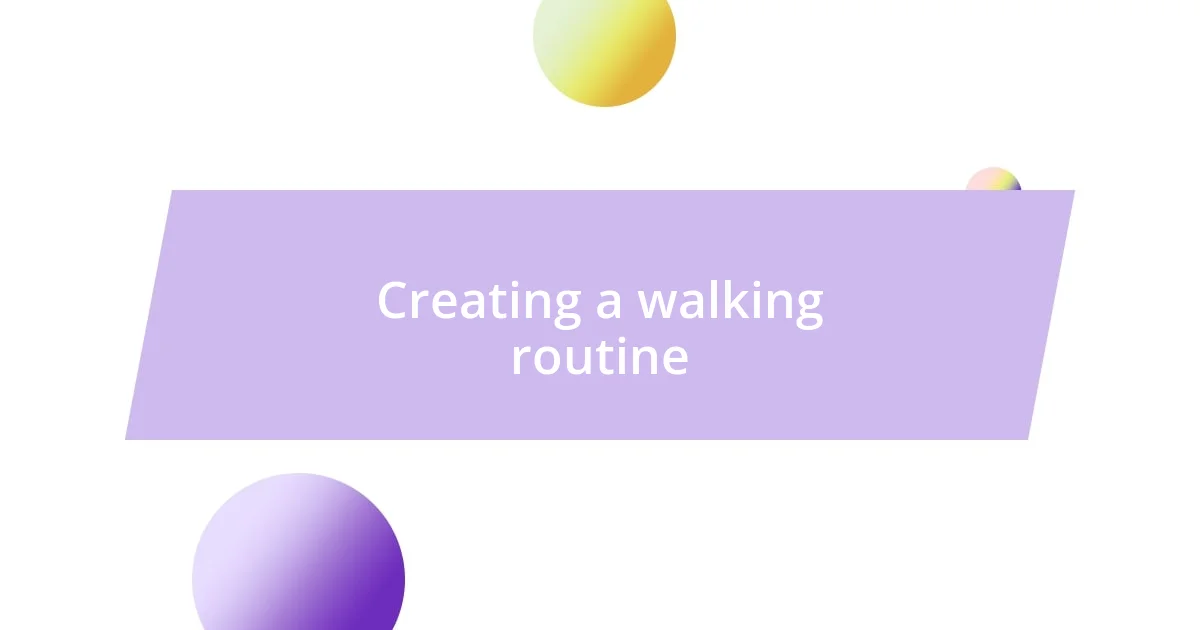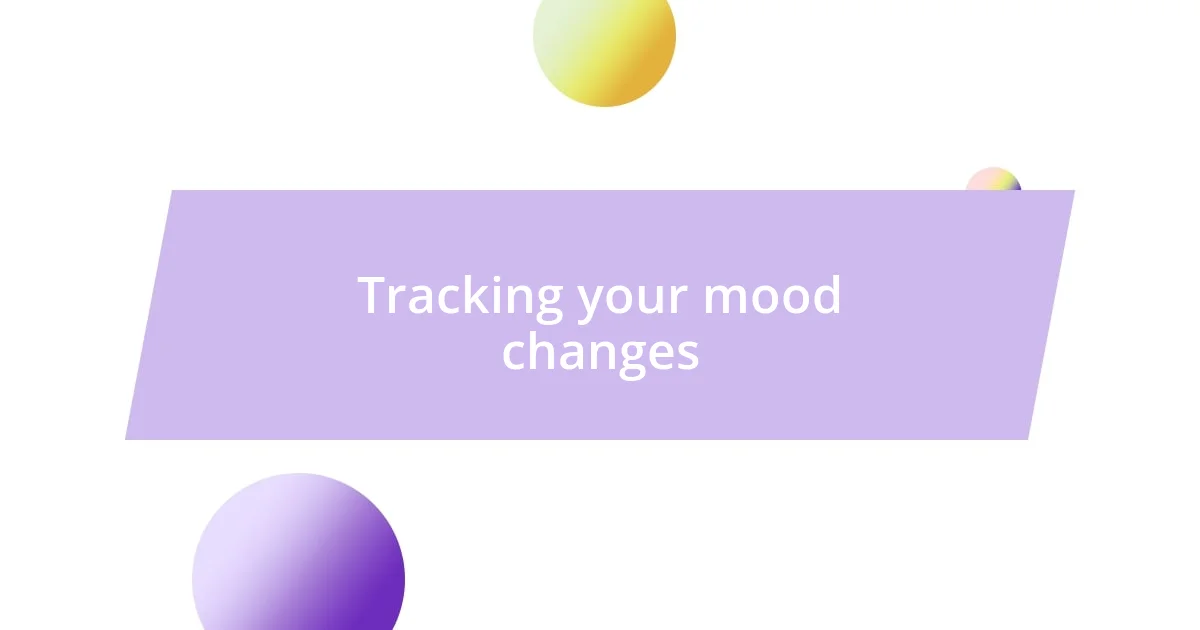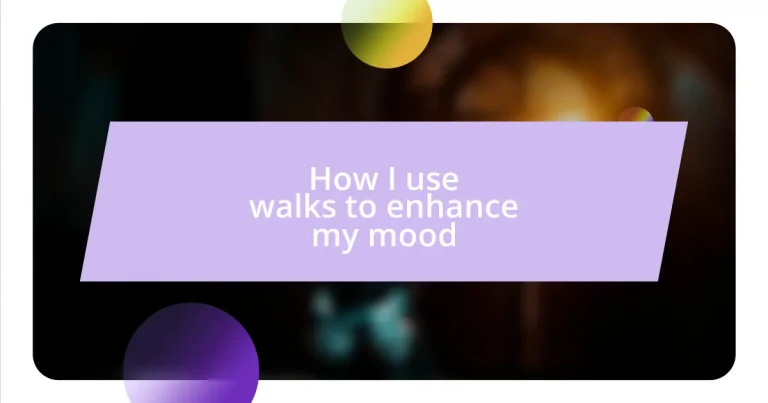Key takeaways:
- Walking significantly boosts mental health by increasing endorphins and providing clarity, especially when in nature.
- Establishing a consistent yet flexible walking routine enhances mood, allowing for variety in routes based on personal energy levels.
- Incorporating mindfulness and tracking mood changes during walks can deepen the experience, highlighting the connection between environment, weather, and emotional states.

Why walking improves mental health
Walking has a remarkable way of lifting my spirits, often in ways I don’t fully expect. When I step outside, the rhythm of my footsteps and the fresh air seem to wash away the worries that cloud my mind. Have you ever noticed how a simple stroll can clear your head, almost like hitting the reset button?
Scientifically, walking increases endorphins—those magical chemicals that cause feelings of happiness. I remember a particularly gloomy time when just a fifteen-minute walk turned my day around, bringing clarity and a sense of peace. Isn’t it fascinating how a little movement can profoundly influence our mental state?
Additionally, being in nature during my walks enhances this effect even more. I often find my mood shifting as I take in the sights, sounds, and scents around me. Does nature have that power for you too? The beauty of a blooming flower or the rustle of leaves can inspire and ground me, reminding me that there’s beauty in the world even during tough times.

Creating a walking routine
Creating a consistent walking routine has shaped my approach to enhancing my mood. I usually set aside 30 minutes each day, picking a time when I feel the need for a break. There’s something comforting about knowing I have that period reserved just for myself, almost like a mini-therapy session.
I’ve learned that variety is key in keeping my walks engaging. Whether it’s a brisk walk around my neighborhood or meandering through a local park, each path offers a fresh perspective. A couple of months ago, I decided to explore the trails near a nearby lake, and I was amazed at how the serenity of the water reflected my improved mood.
Stay flexible with your routine, too. Sometimes, it’s important to heed my body’s signals. If I’m feeling particularly energetic, I might opt for a more challenging route. On slower days, a gentle walk suffices, reminding me that every step counts.
| Walking Routine Aspect | My Approach |
|---|---|
| Duration | 30 minutes daily |
| Variety | Mix of routes: neighborhood, parks, and trails |
| Flexibility | Adjust based on mood and energy levels |

Choosing the right walking environment
Choosing the right walking environment can significantly impact the mood-enhancing effects of my strolls. I favor places with greenery, where the hustle and bustle of the city fades away. A few weeks ago, I decided to take my routine to the local botanical garden. The vibrant flowers, fluttering butterflies, and the soft buzz of bees created a peaceful atmosphere that felt like a warm hug for my senses.
Here are some aspects to consider when selecting your walking environment:
- Natural Surroundings: Opt for parks, gardens, or nature trails that provide greenery and tranquility.
- Quiet Areas: Look for less crowded locations to minimize distractions and promote mindfulness.
- Scenic Views: Choose routes with beautiful landscapes that inspire a sense of wonder and appreciation.
Another essential factor for me is accessibility. I often find myself preferring paths that I can easily reach. My favorite walking spots are within a short drive or bike ride from home. Last Saturday, I ventured to a nearby lake at sunrise, and the stillness of the water mirrored my mood, creating a serene start to my day. Choosing an environment that feels comfortable and inviting can truly elevate my walking experience, making it more enjoyable and beneficial for my well-being.

Incorporating mindfulness into walks
Incorporating mindfulness into my walks has transformed the way I experience them. During my strolls, I consciously focus on my surroundings—breathing in the fresh air and noticing the colors around me. Just the other day, while walking through a quiet park, I paused to listen to the crunch of leaves beneath my feet. Have you ever noticed how grounding this simple act can be? It really brings my mind into the present.
I also practice gratitude on these walks. I take a moment to appreciate everything—the vibrant flowers, the soft rustle of the trees, and even the playful squirrels. This mindset helps shift my perspective when I’m feeling overwhelmed. A few weeks back, I came across a blooming cherry blossom tree. Standing there in awe, I felt a wave of appreciation wash over me. It reminded me that beauty exists even in uncertain times.
Another beneficial technique is the practice of mindful walking, where each step becomes a focus point. I try to be aware of my body, the rhythm of my breath, and the sensations of each movement. On days when my mind feels cluttered with thoughts, this practice brings clarity. It’s almost meditative; wrapping myself in the simplicity of the moment allows me to let go of stress and reconnect with myself. How do you think mindfulness could change your experience during walks?

Tracking your mood changes
Tracking my mood changes during my walks is something I take seriously. I’ve found that keeping a simple journal can be incredibly effective. After each walk, I jot down how I felt before, during, and after my stroll. This practice has given me profound insights into what specific settings or moments correlate with a boost in my mood. Have you ever stopped to consider how the weather might influence your feelings?
On days when the sun shines, I’ve noticed an immediate lift in my spirits. Conversely, during overcast days, I might feel a bit blue. Recently, I walked in a light drizzle and discovered a peculiar joy in the fresh scent of wet earth. Reflecting on my mood afterwards, I realized that embracing the elements can sometimes enhance my experience rather than detract from it. Isn’t it fascinating how even a drizzle can initiate a change in perspective?
Additionally, I utilize mood tracking apps to identify patterns in my emotions over time. These tools reveal intriguing links between my walking habits and emotional states. For instance, I recently discovered that walks after lunch tended to leave me feeling more energized and clear-headed. By analyzing this data, I can adjust my walking schedule or environment accordingly. How do you approach your mood tracking? Finding what works for you can be a game-changer.














